A Japanese space probe known as Hayabusa 2 has reached a small “diamond shaped” asteroid known as Ryugu after four long years and covering 2 billion miles. The official press release, posted by the Japan Aerospace Exploration Agency (JAXA) reports that the unmanned spacecraft will now collect samples of space rock from the asteroid using a range of equipment including a lander and three small robotic rovers and will finally return to earth with samples of Ryugu’s rocks in November 2020. Scientists at JAXA are really hoping that Hayabusa completes its mission without any hurdles because the success of the mission would mean samples of an asteroid rock being brought to earth only for the second time. Other space probes like NASA’s Galileo have also visited asteroids in the past but only the first Hayabusa probe was successful in returning to earth with asteroid rock samples.
Hayabusa 2 was successful in giving us all various photographs of the diamond-shaped asteroid. The asteroid looks like a big rock with craters here and there in a photograph taken by Hayabusa 2 on June 24. While Hayabusa or Hayabusa 1’s mission was successful and it did bring back samples from the asteroid 25143 Itokawa but the rock samples weren’t as large enough as the scientists expected and the overall collected scientific data was found to be insufficient. Maybe Hayabusa 2 will now collect much larger rock samples and provide more data on asteroids that might prove useful for scientists.

Hayabusa 2’s success would also bring new hope to the Japanese space program that recently experienced quite a lot of unfortunate events- like the 2016 military communication satellite mishap. Ryugu is said to be a C-type asteroid and not a S-type asteroid like Itokawa. C-type asteroid rocks are more likely to be made up of organic substances and water. If the samples of the C-type asteroids would reach the Earth safely in 2020, scientists will be able to collect more data on whether the organic materials in the asteroid rocks are similar to those that exist here on Earth. The findings will surely help scientists with the perplex question of how life was formed on Earth.

